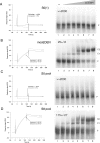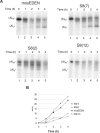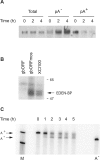CUG-BP1/CELF1 requires UGU-rich sequences for high-affinity binding
- PMID: 16938098
- PMCID: PMC1652823
- DOI: 10.1042/BJ20060490
CUG-BP1/CELF1 requires UGU-rich sequences for high-affinity binding
Abstract
CUG-BP1 [CUG-binding protein 1 also called CELF (CUG-BP1 and ETR3 like factors) 1] is a human RNA-binding protein that has been implicated in the control of splicing and mRNA translation. The Xenopus homologue [EDEN-BP (embryo deadenylation element-binding protein)] is required for rapid deadenylation of certain maternal mRNAs just after fertilization. A variety of sequence elements have been described as target sites for these two proteins but their binding specificity is still controversial. Using a SELEX (systematic evolution of ligand by exponential enrichment) procedure and recombinant CUG-BP1 we selected two families of aptamers. Surface plasmon resonance and electrophoretic mobility-shift assays showed that these two families differed in their ability to bind CUG-BP1. Furthermore, the selected high-affinity aptamers form two complexes with CUG-BP1 in electrophoretic mobility assays whereas those that bind with low affinity only form one complex. The validity of the distinction between the two families of aptamers was confirmed by a functional in vivo deadenylation assay. Only those aptamers that bound CUG-BP1 with high affinity conferred deadenylation on a reporter mRNA. These high-affinity RNAs are characterized by a richness in UGU motifs. Using these binding site characteristics we identified the Xenopus maternal mRNA encoding the MAPK (mitogen-activated protein kinase) phosphatase (XCl100alpha) as a substrate for EDEN-BP. In conclusion, high-affinity CUG-BP1 binding sites are sequence elements at least 30 nucleotides in length that are enriched in combinations of U and G nucleotides and contain at least 4 UGU trinucleotide motifs. Such sequence elements are functionally competent to target an RNA for deadenylation in vivo.
Figures






References
-
- Timchenko L. T., Timchenko N. A., Caskey C. T., Roberts R. Novel proteins with binding specificity for DNA CTG repeats and RNA CUG repeats: implications for myotonic dystrophy. Hum. Mol. Genet. 1996;5:115–121. - PubMed
-
- Barreau C., Paillard L., Mereau A., Osborne H. B. Mammalian CELF/Bruno-like RNA-binding proteins: molecular characteristics and biological functions. Biochimie. 2006;88:515–525. - PubMed
-
- Philips A. V., Timchenko L. T., Cooper T. A. Disruption of splicing regulated by a CUG-binding protein in myotonic dystrophy. Science. 1998;280:737–741. - PubMed
-
- Ho T. H., Bundman D., Armstrong D. L., Cooper T. A. Transgenic mice expressing CUG-BP1 reproduce splicing mis-regulation observed in myotonic dystrophy. Hum. Mol. Genet. 2005;14:1539–1547. - PubMed
Publication types
MeSH terms
Substances
LinkOut - more resources
Full Text Sources
Research Materials

